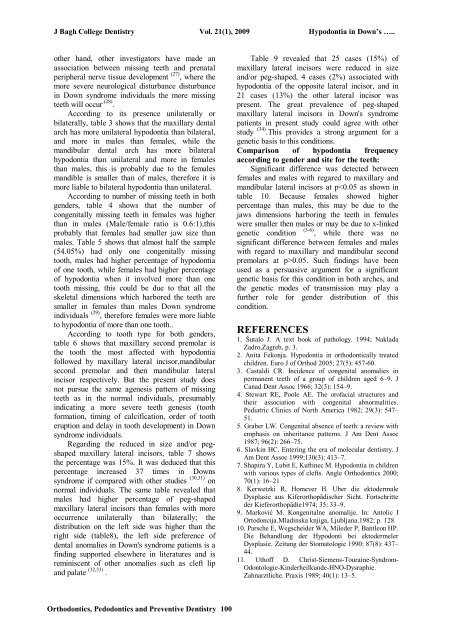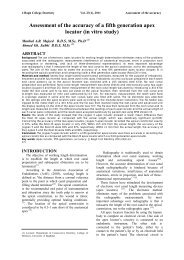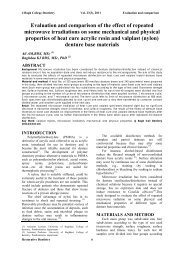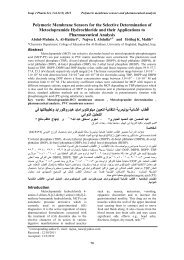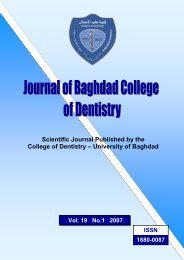Vol 21 No. 1
Vol 21 No. 1
Vol 21 No. 1
You also want an ePaper? Increase the reach of your titles
YUMPU automatically turns print PDFs into web optimized ePapers that Google loves.
J Bagh College Dentistry <strong>Vol</strong>. <strong>21</strong>(1), 2009 Hypodontia in Down’s …..<br />
other hand, other investigators have made an<br />
association between missing teeth and prenatal<br />
peripheral nerve tissue development (27) , where the<br />
more severe neurological disturbance disturbance<br />
in Down syndrome individuals the more missing<br />
teeth will occur (28) .<br />
According to its presence unilaterally or<br />
bilaterally, table 3 shows that the maxillary dental<br />
arch has more unilateral hypodontia than bilateral,<br />
and more in males than females, while the<br />
mandibular dental arch has more bilateral<br />
hypodontia than unilateral and more in females<br />
than males, this is probably due to the females<br />
mandible is smaller than of males, therefore it is<br />
more liable to bilateral hypodontia than unilateral.<br />
According to number of missing teeth in both<br />
genders, table 4 shows that the number of<br />
congenitally missing teeth in females was higher<br />
than in males (Male/female ratio is 0.6:1),this<br />
probably that females had smaller jaw size than<br />
males. Table 5 shows that almost half the sample<br />
(54.05%) had only one congenitally missing<br />
tooth, males had higher percentage of hypodontia<br />
of one tooth, while females had higher percentage<br />
of hypodontia when it involved more than one<br />
tooth missing, this could be due to that all the<br />
skeletal dimensions which harbored the teeth are<br />
smaller in females than males Down syndrome<br />
individuals (29) , therefore females were more liable<br />
to hypodontia of more than one tooth..<br />
According to tooth type for both genders,<br />
table 6 shows that maxillary second premolar is<br />
the tooth the most affected with hypodontia<br />
followed by maxillary lateral incisor,mandibular<br />
second premolar and then mandibular lateral<br />
incisor respectively. But the present study does<br />
not pursue the same agenesis pattern of missing<br />
teeth as in the normal individuals, presumably<br />
indicating a more severe teeth genesis (tooth<br />
formation, timing of calcification, order of tooth<br />
eruption and delay in tooth development) in Down<br />
syndrome individuals.<br />
Regarding the reduced in size and/or pegshaped<br />
maxillary lateral incisors, table 7 shows<br />
the percentage was 15%. It was deduced that this<br />
percentage increased 37 times in Downs<br />
syndrome if compared with other studies (30,31) on<br />
normal individuals. The same table revealed that<br />
males had higher percentage of peg-shaped<br />
maxillary lateral incisors than females with more<br />
occurrence unilaterally than bilaterally; the<br />
distribution on the left side was higher than the<br />
right side (table8), the left side preference of<br />
dental anomalies in Down's syndrome patients is a<br />
finding supported elsewhere in literatures and is<br />
reminiscent of other anomalies such as cleft lip<br />
and palate (32,33) .<br />
Table 9 revealed that 25 cases (15%) of<br />
maxillary lateral incisors were reduced in size<br />
and/or peg-shaped, 4 cases (2%) associated with<br />
hypodontia of the opposite lateral incisor, and in<br />
<strong>21</strong> cases (13%) the other lateral incisor was<br />
present. The great prevalence of peg-shaped<br />
maxillary lateral incisors in Down's syndrome<br />
patients in present study could agree with other<br />
study (34) .This provides a strong argument for a<br />
genetic basis to this conditions.<br />
Comparison of hypodontia frequency<br />
according to gender and site for the teeth:<br />
Significant difference was detected between<br />
females and males with regared to maxillary and<br />
mandibular lateral incisors at p0.05. Such findings have been<br />
used as a persuasive argument for a significant<br />
genetic basis for this condition in both arches, and<br />
the genetic modes of transmission may play a<br />
further role for gender distribution of this<br />
condition.<br />
REFERENCES<br />
1. Šutalo J. A text book of pathology. 1994; Naklada<br />
Zadro,Zagreb, p. 3.<br />
2. Anita Fekonja. Hypodontia in orthodontically treated<br />
children. Euro J of Orthod 2005; 27(5): 457-60.<br />
3. Castaldi CR. Incidence of congenital anomalies in<br />
permanent teeth of a group of children aged 6–9. J<br />
Canad Dent Assoc 1966; 32(3): 154–9.<br />
4. Stewart RE, Poole AE. The orofacial structures and<br />
their association with congenital abnormalities.<br />
Pediatric Clinics of <strong>No</strong>rth America 1982; 29(3): 547–<br />
51.<br />
5. Graber LW. Congenital absence of teeth: a review with<br />
emphasis on inheritance patterns. J Am Dent Assoc<br />
1987; 96(2): 266–75.<br />
6. Slavkin HC. Entering the era of molecular dentistry. J<br />
Am Dent Assoc 1999;130(3): 413–7.<br />
7. Shapira Y, Lubit E, Kuftinec M. Hypodontia in children<br />
with various types of clefts. Angle Orthodontics 2000;<br />
70(1): 16–<strong>21</strong><br />
8. Kerwetzki R, Homever H. Uber die ektodermale<br />
Dysplasie aus Kiferorthopädischer Sicht. Fortschritte<br />
der Kieferorthopädie1974; 35: 33–9.<br />
9. Marković M. Kongenitalne anomalije. In: Antolic I<br />
Ortodoncija.Mladinska knjiga, Ljubljana.1982; p. 128<br />
10. Parsche E, Wegscheider WA, Mileder P, Bantleon HP.<br />
Die Behandlung der Hypodonti bei ektodermeler<br />
Dysplasie. Zeitung der Stomatologie 1990; 87(8): 437–<br />
44.<br />
11. Uthoff D. Christ-Siemens-Touraine-Syndrom-<br />
Odontologie-Kinderheilkunde-HNO-Dysraphie.<br />
Zahnarztliche. Praxis 1989; 40(1): 13–5.<br />
Orthodontics, Pedodontics and Preventive Dentistry 100


